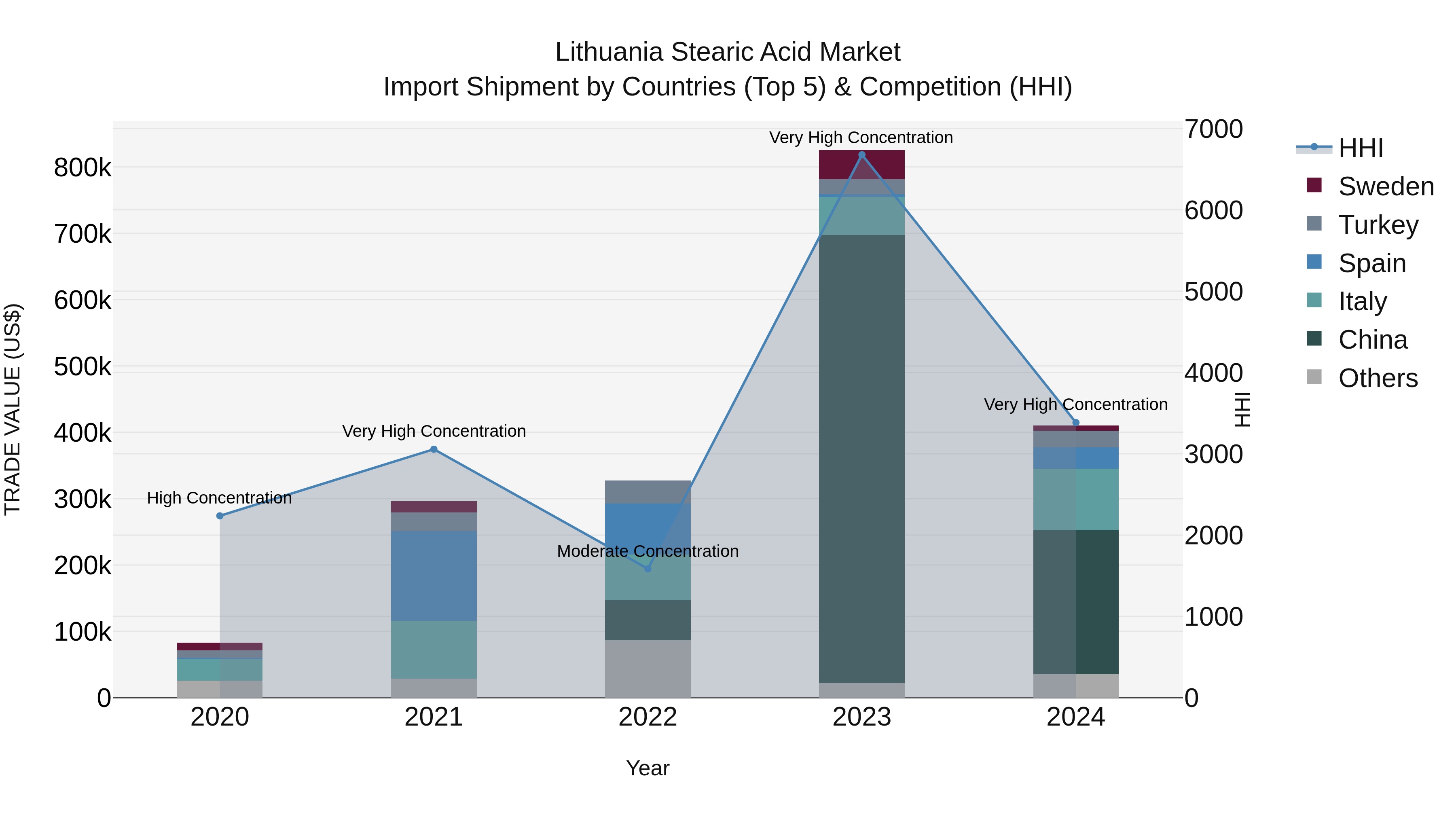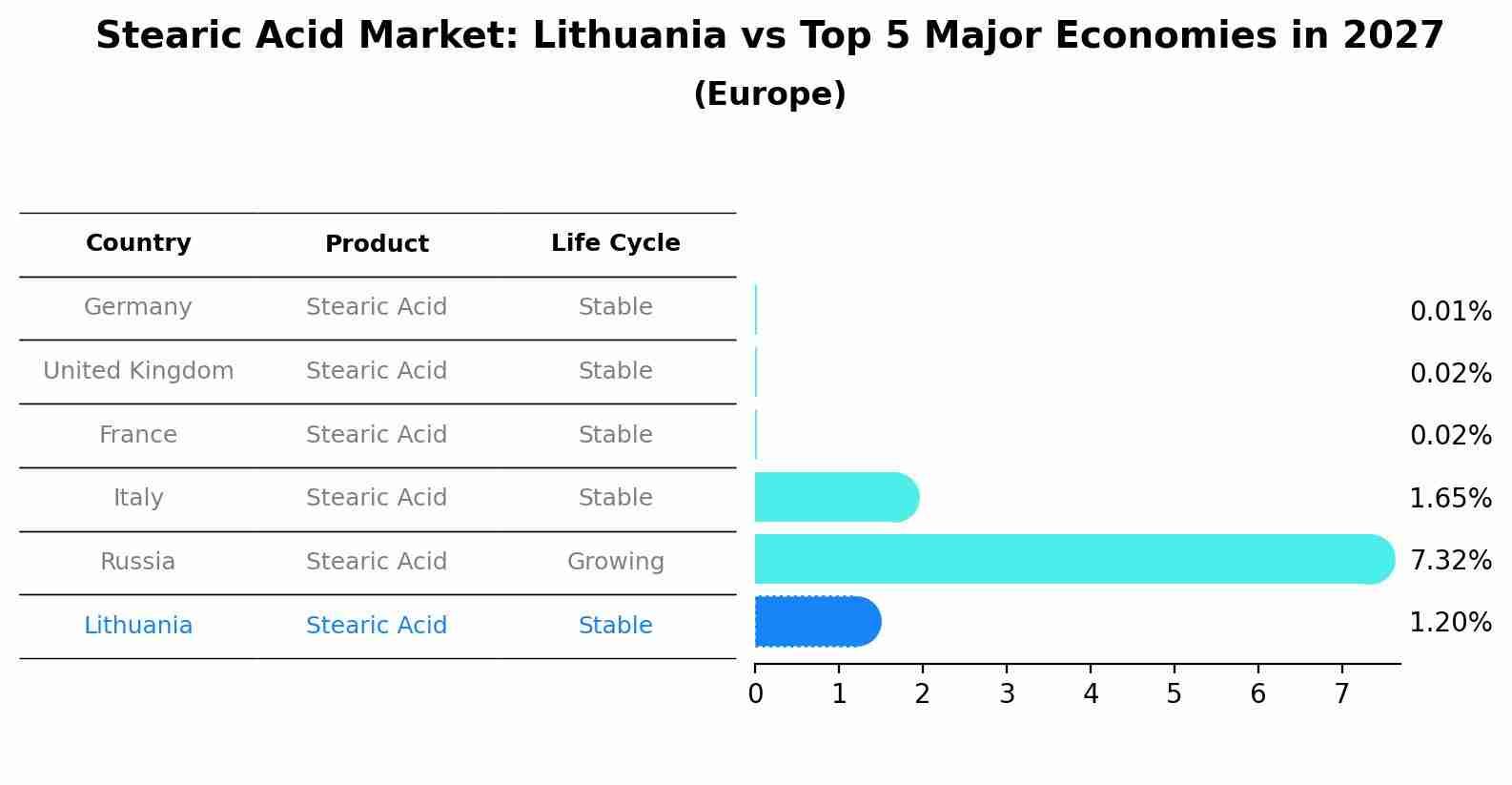Lithuania Stearic Acid Market (2025-2031) | Growth, Revenue, Segmentation, Share, Companies, Industry, Trends, Value, Analysis, Outlook, Forecast & Size
| Product Code: ETC4683388 | Publication Date: Nov 2023 | Updated Date: Nov 2025 | Product Type: Market Research Report | |
| Publisher: 6Wresearch | Author: Shubham Padhi | No. of Pages: 60 | No. of Figures: 30 | No. of Tables: 5 |
Lithuania Stearic Acid Market Top 5 Importing Countries and Market Competition (HHI) Analysis
In 2024, Lithuania continued to be a prominent importer of stearic acid, with top suppliers being China, Italy, Spain, Turkey, and Poland. Despite a significant negative growth rate in 2024 compared to the previous year, the compound annual growth rate (CAGR) from 2020 to 2024 was notably high at 49.23%. The market concentration, as measured by the Herfindahl-Hirschman Index (HHI), remained at a very high level in 2024, indicating a concentrated market structure dominated by these key exporting countries. This suggests ongoing reliance on these suppliers for stearic acid imports in Lithuania.

Stearic Acid Market: Lithuania vs Top 5 Major Economies in 2027 (Europe)
The Stearic Acid market in Lithuania is projected to grow at a stable growth rate of 1.20% by 2027, highlighting the country's increasing focus on advanced technologies within the Europe region, where Germany holds the dominant position, followed closely by United Kingdom, France, Italy and Russia, shaping overall regional demand.

Key Highlights of the Report:
- Lithuania Stearic Acid Market Outlook
- Market Size of Lithuania Stearic Acid Market, 2024
- Forecast of Lithuania Stearic Acid Market, 2031
- Historical Data and Forecast of Lithuania Stearic Acid Revenues & Volume for the Period 2021-2031
- Lithuania Stearic Acid Market Trend Evolution
- Lithuania Stearic Acid Market Drivers and Challenges
- Lithuania Stearic Acid Price Trends
- Lithuania Stearic Acid Porter`s Five Forces
- Lithuania Stearic Acid Industry Life Cycle
- Historical Data and Forecast of Lithuania Stearic Acid Market Revenues & Volume By Feedstock for the Period 2021-2031
- Historical Data and Forecast of Lithuania Stearic Acid Market Revenues & Volume By Animal-based Raw Materials for the Period 2021-2031
- Historical Data and Forecast of Lithuania Stearic Acid Market Revenues & Volume By Vegetable-based Raw Materials for the Period 2021-2031
- Historical Data and Forecast of Lithuania Stearic Acid Market Revenues & Volume By Applications for the Period 2021-2031
- Historical Data and Forecast of Lithuania Stearic Acid Market Revenues & Volume By Soaps and Detergents for the Period 2021-2031
- Historical Data and Forecast of Lithuania Stearic Acid Market Revenues & Volume By Textiles for the Period 2021-2031
- Historical Data and Forecast of Lithuania Stearic Acid Market Revenues & Volume By Lubricants for the Period 2021-2031
- Historical Data and Forecast of Lithuania Stearic Acid Market Revenues & Volume By Personal Care for the Period 2021-2031
- Historical Data and Forecast of Lithuania Stearic Acid Market Revenues & Volume By Rubber Processing for the Period 2021-2031
- Historical Data and Forecast of Lithuania Stearic Acid Market Revenues & Volume By Other Applications for the Period 2021-2031
- Lithuania Stearic Acid Import Export Trade Statistics
- Market Opportunity Assessment By Feedstock
- Market Opportunity Assessment By Applications
- Lithuania Stearic Acid Top Companies Market Share
- Lithuania Stearic Acid Competitive Benchmarking By Technical and Operational Parameters
- Lithuania Stearic Acid Company Profiles
- Lithuania Stearic Acid Key Strategic Recommendations
Frequently Asked Questions About the Market Study (FAQs):
1 Executive Summary |
2 Introduction |
2.1 Key Highlights of the Report |
2.2 Report Description |
2.3 Market Scope & Segmentation |
2.4 Research Methodology |
2.5 Assumptions |
3 Lithuania Stearic Acid Market Overview |
3.1 Lithuania Country Macro Economic Indicators |
3.2 Lithuania Stearic Acid Market Revenues & Volume, 2021 & 2031F |
3.3 Lithuania Stearic Acid Market - Industry Life Cycle |
3.4 Lithuania Stearic Acid Market - Porter's Five Forces |
3.5 Lithuania Stearic Acid Market Revenues & Volume Share, By Feedstock, 2021 & 2031F |
3.6 Lithuania Stearic Acid Market Revenues & Volume Share, By Applications, 2021 & 2031F |
4 Lithuania Stearic Acid Market Dynamics |
4.1 Impact Analysis |
4.2 Market Drivers |
4.3 Market Restraints |
5 Lithuania Stearic Acid Market Trends |
6 Lithuania Stearic Acid Market Segmentations |
6.1 Lithuania Stearic Acid Market, By Feedstock |
6.1.1 Overview and Analysis |
6.1.2 Lithuania Stearic Acid Market Revenues & Volume, By Animal-based Raw Materials, 2021-2031F | 6.1.4 Lithuania Stearic Acid Market Revenues & Volume, By Vegetable-based Raw Materials, 2021-2031F |
6.2 Lithuania Stearic Acid Market, By Applications |
6.2.1 Overview and Analysis |
6.2.2 Lithuania Stearic Acid Market Revenues & Volume, By Soaps and Detergents, 2021-2031F |
6.2.3 Lithuania Stearic Acid Market Revenues & Volume, By Textiles, 2021-2031F |
6.2.4 Lithuania Stearic Acid Market Revenues & Volume, By Lubricants, 2021-2031F |
6.2.5 Lithuania Stearic Acid Market Revenues & Volume, By Personal Care, 2021-2031F |
6.2.6 Lithuania Stearic Acid Market Revenues & Volume, By Rubber Processing, 2021-2031F |
6.2.7 Lithuania Stearic Acid Market Revenues & Volume, By Other Applications, 2021-2031F |
7 Lithuania Stearic Acid Market Import-Export Trade Statistics |
7.1 Lithuania Stearic Acid Market Export to Major Countries |
7.2 Lithuania Stearic Acid Market Imports from Major Countries |
8 Lithuania Stearic Acid Market Key Performance Indicators |
9 Lithuania Stearic Acid Market - Opportunity Assessment |
9.1 Lithuania Stearic Acid Market Opportunity Assessment, By Feedstock, 2021 & 2031F |
9.2 Lithuania Stearic Acid Market Opportunity Assessment, By Applications, 2021 & 2031F |
10 Lithuania Stearic Acid Market - Competitive Landscape |
10.1 Lithuania Stearic Acid Market Revenue Share, By Companies, 2024 |
10.2 Lithuania Stearic Acid Market Competitive Benchmarking, By Operating and Technical Parameters |
11 Company Profiles |
12 Recommendations | 13 Disclaimer |
- Single User License$ 1,995
- Department License$ 2,400
- Site License$ 3,120
- Global License$ 3,795
Search
Thought Leadership and Analyst Meet
Our Clients
Related Reports
- Afghanistan Apparel Market (2026-2032) | Growth, Outlook, Industry, Segmentation, Forecast, Size, Companies, Trends, Value, Share, Analysis & Revenue
- Canada Oil and Gas Market (2026-2032) | Share, Segmentation, Value, Industry, Trends, Forecast, Analysis, Size & Revenue, Growth, Competitive Landscape, Outlook, Companies
- Germany Breakfast Food Market (2026-2032) | Industry, Share, Growth, Size, Companies, Value, Analysis, Revenue, Trends, Forecast & Outlook
- Australia Briquette Market (2025-2031) | Growth, Size, Revenue, Forecast, Analysis, Trends, Value, Share, Industry & Companies
- Vietnam System Integrator Market (2025-2031) | Size, Companies, Analysis, Industry, Value, Forecast, Growth, Trends, Revenue & Share
- ASEAN and Thailand Brain Health Supplements Market (2025-2031) | Strategy, Consumer Insights, Analysis, Investment Trends, Opportunities, Growth, Size, Share, Industry, Revenue, Segments, Value, Segmentation, Supply, Forecast, Restraints, Outlook, Competition, Drivers, Trends, Demand, Pricing Analysis, Competitive, Strategic Insights, Companies, Challenges
- ASEAN Bearings Market (2025-2031) | Strategy, Consumer Insights, Analysis, Investment Trends, Opportunities, Growth, Size, Share, Industry, Revenue, Segments, Value, Segmentation, Supply, Forecast, Restraints, Outlook, Competition, Drivers, Trends, Demand, Pricing Analysis, Competitive, Strategic Insights, Companies, Challenges
- Europe Flooring Market (2025-2031) | Outlook, Share, Industry, Trends, Forecast, Companies, Revenue, Size, Analysis, Growth & Value
- Saudi Arabia Manlift Market (2025-2031) | Outlook, Size, Growth, Trends, Companies, Industry, Revenue, Value, Share, Forecast & Analysis
- Uganda Excavator, Crane, and Wheel Loaders Market (2025-2031) | Strategy, Consumer Insights, Analysis, Investment Trends, Opportunities, Growth, Size, Share, Industry, Revenue, Segments, Value, Segmentation, Supply, Forecast, Restraints, Outlook, Competition, Drivers, Trends, Demand, Pricing Analysis, Competitive, Strategic Insights, Companies, Challenges
Industry Events and Analyst Meet
Whitepaper
- Middle East & Africa Commercial Security Market Click here to view more.
- Middle East & Africa Fire Safety Systems & Equipment Market Click here to view more.
- GCC Drone Market Click here to view more.
- Middle East Lighting Fixture Market Click here to view more.
- GCC Physical & Perimeter Security Market Click here to view more.
6WResearch In News
- Doha a strategic location for EV manufacturing hub: IPA Qatar
- Demand for luxury TVs surging in the GCC, says Samsung
- Empowering Growth: The Thriving Journey of Bangladesh’s Cable Industry
- Demand for luxury TVs surging in the GCC, says Samsung
- Video call with a traditional healer? Once unthinkable, it’s now common in South Africa
- Intelligent Buildings To Smooth GCC’s Path To Net Zero


















